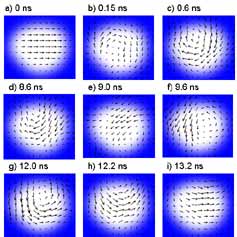
Handy Links
SLAC News Center
SLAC Today
- Subscribe
- Archives: Feb 2006-May 20, 2011
- Archives: May 23, 2011 and later
- Submit Feedback or Story Ideas
- About SLAC Today
SLAC News
Lab News
- Interactions
- Lightsources.org
- ILC NewsLine
- Int'l Science Grid This Week
- Fermilab Today
- Berkeley Lab News
- @brookhaven TODAY
- DOE Pulse
- CERN Courier
- DESY inForm
- US / LHC
SLAC Links
- Emergency
- Safety
- Policy Repository
- Site Entry Form

- Site Maps
- M & O Review
- Computing Status & Calendar
- SLAC Colloquium
- SLACspeak
- SLACspace
- SLAC Logo
- Café Menu
- Flea Market
- Web E-mail
- Marguerite Shuttle
- Discount Commuter Passes
-
Award Reporting Form
- SPIRES
- SciDoc
- Activity Groups
- Library
Stanford
Around the Bay
A Glimpse of the Future: Spin-polarized Computing
 Imagine a computer that never has to boot up—flip the switch and it's immediately on, turn it off
and it never loses information.
Imagine a computer that never has to boot up—flip the switch and it's immediately on, turn it off
and it never loses information.
Home computers today can not pull this off because of a gap in the two types of computer memory currently in use. Random access memory (RAM) is where most computer processes take place. RAM chips are fast, but they lose information as soon as the power is turned off. Hard disks are where operating software is stored. They are inexpensive and retain information even after being switched off, but they are large, slow mechanical devices. To make computers faster and more reliable, researchers now seek to combine the positive attributes of both RAM and hard disks.
A novel candidate for achieving this is the magnetic random access memory chip, in which the information is stored magnetically on a chip which allows fast access to the information. Researchers at SLAC have recently made a promising breakthrough in understanding a fundamental process associated with such magnetic storage devices.
The SLAC team of John Paul Strachan, Venkatesh Chembrolu, Ashwin Tulapurkar, and Xiaowei Yu led by Yves Acremann, a researcher working under the direction of SSRL Director Joachim StŲhr, has published results of an experiment that gives direct insight into how bits of magnetic memory switch polarity. This process could eventually be used to design fast and efficient magnetic RAM chips.
The fundamental operation of computers is switching between ones and zeroes. In magnetic memory devices, these two states represent the magnetic polarity of a "bit" on a piece of media, such as a magnetic memory chip. The conventional technique for changing between zeros and ones is to use an electromagnet to flip the polarity so that the magnetization points either in one direction or another.
In magnetic memory devices, switching polarity happens fast—less than one nanosecond, or shorter than the amount of time it takes light to travel one foot. The breakthrough aspect of Acremann's research lies in the technique used to obtain precise, high-speed, microscopic measurements of exactly how the magnetic polarity switches back and forth.
Using short pulses of x-rays from an electron accelerator, Acremann and colleagues were able to make a movie illustrating the dynamics of a bitís changing polarity. In this way they compared the conventional technique that uses an electromagnetic field to a novel technique that uses a current of "spin-polarized" electrons.
Electrons have a charge which is used in all conventional electronic devices. But electrons have another property called "spin," whereby the electron acts like a tiny magnet that can point in different directions. A spin-polarized current is a stream of electrons that are aligned so that each electron's spin points in the same direction. Researchers had known that spin-polarized currents can switch the polarity of a magnetic bit, but they were unsure of how exactly the switching process works.
"The assumption was that spin-polarized current changed the magnetic state uniformly," Acremann said. "But we've found that itís more complicated than that."
Acremann's results show that applying spin-polarized current does not, in fact, turn a one into a zero in a single step. The magnetic element undergoes a more complicated transformation that eventually leads to switching, but more research is needed to make the process efficient enough for use in computer memory. For now, Acremann and his team are pleased to have developed a method that enables them to measure exactly what is happening inside the magnetic bit on a microscopic level. The ability to take time-lapse images of a bit as its polarity changes means that computer engineers may soon be able to make use of spin-polarized current in designing faster, non-volatile memory devices.
Consumers will have to wait for this technology to develop. But, Acremann says, once this technology is perfected, it may change how computers are designed. "It will be like combining RAM memory and the hard disk" Acremann said. "You won't have to boot up a computer. When you turn on the switch it will be on instantly."
The research was conducted at the Advanced Light Source in Berkeley, California. Soon, this same research will be possible at SSRL, with the commissioning of beamline 13 in 2007. The end station for the new beamline will house a new scanning transmission x-ray microscope like the one used by Acremann and his team. This device, however, will be more specialized for the study of magnetism, enabling more research like Acremann's.
The article appears in the June 2, 2006 issue of Physical Review Letters.
óBrad Plummer
SLAC Today, June 2, 2006
Image: Diagram showing how the polarity of a magnetic bit changes when injected with a spin-polarized current. To change from a one to a zero, the arrows in panel (a) should flip to the opposite direction. Acremann and his team discovered the movement of the arrows is more complicated than originally suspected.